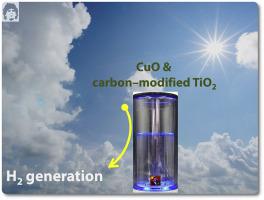Materials Today Energy ( IF 9.0 ) Pub Date : 2020-12-01 , DOI: 10.1016/j.mtener.2020.100607 D.M. Tobaldi , K. Kočí , M. Edelmannová , L. Lajaunie , B. Figueiredo , J.J. Calvino , M.P. Seabra , J.A. Labrincha

|
Hydrogen, as an energy carrier, is a zero-emission fuel. Being green and clean, it is considered to play an important role in energy and environmental issues. Photocatalytic water splitting is a process used to generate hydrogen from the dissociation of water. Titanium dioxide is the archetype material for photocatalytic water splitting. However, because of the fast recombination of the photo-generated exciton, the yield of the reaction is typically low. To overcome this limit, in this work, the surface of the TiO2 nanoparticles was modified with copper and graphene to give hybrid nanostructures. Synthesized materials were tested in the photocatalytic hydrogen generation using methanol as the sacrificial agent. X-ray diffraction and spectroscopic results showed that copper did not enter the TiO2 structure, and that neither copper nor graphene substantially altered the optical band-gap of prepared photocatalysts. Detailed aberration-corrected high-resolution electron transmission electron imaging and spatially resolved energy-loss spectroscopy experiments showed the oxidation and amorphization of graphene nanoplatelets, probably due to the combined action of the acidic media of the solution with the thermal treatment necessary to produce the hybrid materials. Hydrogen generation from methanol/water mix proved that exists an optimum concentration of both copper and graphene (i.e. 0.5 mol% copper plus 0.5 wt% graphene) to grant a two-fold increase in hydrogen production compared with that of unmodified titania when using UVA irradiation. A higher amount of initial graphene (i.e. 1.0 wt% graphene and 0.5 mol% copper) was instead necessary for granting higher H2 generation on visible-light exposure. Hybrid materials based on titania modified with both copper oxide and carbon-based materials could therefore be exploited as ideal candidates for light-to-energy applications.
中文翻译:

用于光催化辅助H 2生成的Cu x O和碳改性的TiO 2基杂化材料
氢作为能量载体是零排放燃料。由于绿色环保,它在能源和环境问题中起着重要作用。光催化水分解是用于从水的离解中产生氢的过程。二氧化钛是用于光催化水分解的原型材料。然而,由于光生激子的快速重组,反应的产率通常较低。为了克服该限制,在这项工作中,用铜和石墨烯对TiO 2纳米颗粒的表面进行了改性,以得到杂化的纳米结构。使用甲醇作为牺牲剂,在光催化制氢中测试了合成材料。X射线衍射和光谱结果表明铜没有进入TiO 2结构,并且铜和石墨烯都不会实质上改变制得的光催化剂的光学带隙。详细的像差校正高分辨率电子透射电子成像和空间分辨能量损失谱实验表明,石墨烯纳米片的氧化和非晶化,可能是由于溶液的酸性介质与产生杂化物所需的热处理共同作用的结果材料。由甲醇/水混合物产生的氢气证明,使用UVA照射时,铜和石墨烯均存在最佳浓度(即0.5 mol%的铜加0.5 wt%的石墨烯),与未改性的二氧化钛相比,氢的产量增加了两倍。 。较高数量的初始石墨烯(即1.0 wt%的石墨烯和0。在可见光下可产生2代。因此,可以将基于氧化钛和氧化铜以及碳基材料改性的杂化材料用作光能应用的理想候选材料。











































 京公网安备 11010802027423号
京公网安备 11010802027423号